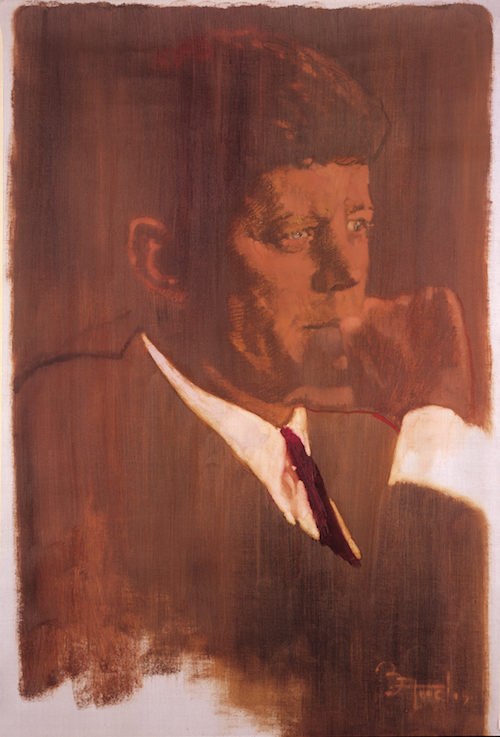The Art of the Post: Two Kennedy Portraits Reveal the Changing Times
John F. Kennedy was elected president in 1960, at the dawn of a decade of great social change. The ‘60s became known for its civil rights, women’s rights and anti-war protests; it was the decade of the Beatles and of Woodstock, of bold new styles and artistic innovation. As Kennedy proclaimed in his inaugural speech, “The torch has been passed to a new generation of Americans.”
There are many different ways to view that great cultural transformation, but perhaps one of the best ways to visualize it is to compare two portraits of JFK himself—before and after his election—by Saturday Evening Post illustrators. What a difference a couple of years makes!
This first portrait was painted in the traditional style by Norman Rockwell for the cover of the Post in 1960, before JFK became president.

The Post had asked Rockwell to create portraits of both Nixon and Kennedy that year. Rockwell was nearing his retirement but went to the Kennedy family compound in Hyannis Port, Massachusetts, before the Democratic National Convention and began work on the cover portrait. Rockwell came to like Kennedy and ultimately voted for him, but kept his vote secret because the Post endorsed Nixon that year. Rockwell worked hard to make sure that his paintings of the two candidates were exactly equal, and no Post reader ever accused him of favoritism.
Even as Rockwell’s cover appeared on the newsstands, a bold new generation of illustrators was arriving on the scene. One of the most promising was the young Bernie Fuchs, whose fresh new style looked very different from Rockwell’s. Like Rockwell, Fuchs would go on to become an illustrator for the Post. In 1962 Fuchs was summoned to the White House to paint a new portrait of JFK.

I interviewed Fuchs about his experiences with JFK for my new art book, The Life and Art of Bernie Fuchs. Fuchs recalled that as the president began to pose, he looked the artist over and said doubtfully, “You seem awfully young to be such an important artist.” Fuchs, who had been sizing up the president from an artist’s perspective, was just thinking that Kennedy seemed awfully young to be president, but kept silent. What Fuchs did not find out until later was that the young president had just been informed that the Soviet Union had placed missiles in Cuba. In a few days, the world would be embroiled in the Cuban Missile Crisis. The torch had indeed been passed to a new generation.

When the portrait was completed, it had a vigorous, dynamic style that the president loved. He handed the portrait to his aides and said, “Go show this to Jackie.”
Fuchs went on to do several well-known portraits of JFK. When Jackie Kennedy died in 1994, it was discovered that she had kept two of Fuchs’ pictures in her personal collection. His art seemed to embody the youthful, robust mood of Camelot.



Note the dramatic contrast between Rockwell’s portrait of JFK in 1960 and Fuchs’ portraits just a few years later. These pictures trace the changes in American taste and culture during those years.
Rockwell looked over his shoulder and recognized that he wasn’t able to do what the new generation of illustrators did. Their materials and working methods were very different, and they worked much more spontaneously. Rockwell worked carefully and used many preliminary studies, while Fuchs seemed to have boundless energy and enthusiasm for experimentation. Not only that, but Fuchs worked in an era when clients encouraged experimentation, while Rockwell’s clients preferred a more classical look and had discouraged him from becoming too adventuresome.
When Fuchs first came to the big city as a young artist, his work attracted a lot of attention. Albert Dorne, the president of the Famous Artists School, identified Fuchs as the most promising illustrator of the new generation, so he arranged a lunch meeting in Manhattan to introduce him to Rockwell. In art as in politics, the torch was being passed to a new generation. Fuchs recalled that the two liked each other and respected each other’s work very much, but felt that they didn’t have much in common. The world was changing rapidly, and they were painting for two different audiences.
Fuchs went on to paint illustrations using wild angle shots and new materials.

We have unexpected photographic proof that Rockwell admired and appreciated the bold work of the next generation. A photographer snapped a picture of Rockwell in his studio standing by his wall of inspirational art by great classical artists. He has displayed the work of giants such as Michelangelo, Rembrandt, Dürer, and other great artists. But down in the corner we see that he has also displayed a picture by the new kid on the block, Bernie Fuchs.

Despite his age, Rockwell had the vision to appreciate timeless quality from any generation.